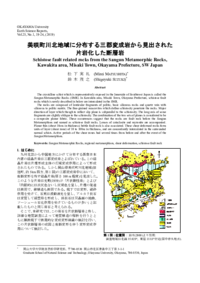

岡山大学 地球科学研究報告
Published by Okayama University Earth Science Reports Editorial Committee
Schistose fault related rocks from the Sangun Metamorphic Rocks, Kawakita area, Misaki Town, Okayama Prefecture, SW Japan
MATSUSHITA, Mirei
Graduate School of Natural Science and Technology, Okayama University
SUZUKI, Shigeyuki
Graduate School of Natural Science and Technology, Okayama University
Kaken ID
publons
researchmap
Published Date
2019-12-27
Abstract
The crystalline schist which is representatively exposed in the Innerside of Southwest Japan is called the Sangun Metamorphic Rocks (SMR). In Kawakita area, Misaki Town, Okayama Prefecture, schistose fault rocks which is newly described in below are intercalated in the SMR. The rocks are composed of lenticular fragments of pelitic, basic siliceous rocks and quartz vein with siliceous to pelitic matrix. The fine-grained muscovites which define schistosity penetrate the rocks. Major direction of layer which though to reflect slip plane is subparallel to the schistosity. The long axis of some fragments are slightly oblique to the schistosity. The combination of the two sets of planes is considered to be a composite planar fabric. These occurrences suggest that the rocks are fault rock before the Sangun Metamorphism and named as schistose fault rocks. Lenses of cataclasite and myronite are accompanied. Planar thin (about 10cm in thickness) brittle fault rock is also associated. These shear deformed rocks form units of layer (shear zone) of 10 to 100m in thickness, and are concordantly intercalated in the surrounded normal schists. Active periods of the shear zones had several times from before and after the event of the Sangun Metamorphism.
Keywords
Sangun Metamorphic Rocks
regional metamorphism
shear deformation
schistose fault rock
ISSN
1340-7414
NCID
AN10506284
JaLCDOI
